« Features
The Defining Moments of Georg Baselitz at Age 80
By Daniel Bonnell
When approaching one of Baselitz’s massive up-side-down paintings you must be on guard. His art acts as walls of seeking and suffering, simplicity and complexity, and profound yet primal beauty. To think about it is to destroy it-one must simply be with the work and if any answers are sought it requires a spirit of humility because those answers may not come. His defining moment that repeats itself throughout his life is that of taking risks at the cost of his complete career. They are risks that are built on a foundation of moving from thinking to being. Welcome to the pilgrimage of Georg Baselitz.
At age 80 Georg Baselitz is the leading protagonist of German post-WWII art whose work never stops reinventing itself. To mark the eightieth birthday of Georg Baselitz, the Foundation Beyeler in Riehen (Basel, Switzerland) is devoting an extensive retrospective to the German painter, printmaker and sculptor, comprising his most important paintings and sculptures. The show juxtaposes key works from each phase of the artist’s oeuvre. The exhibition brings together some ninety paintings and twelve sculptures dating from 1959 to 2017. Exemplary works from the 1960s, with a selection of the “Hero and Fracture” paintings, are included among examples of the inverted images for which Baselitz became famous. Along with the artist’s large-format wood sculptures and reliefs, paintings from the later “Remix” series are also featured, as well as a new group of works, which is publicly displayed here for the first time. The retrospective debuted at the Foundation Beyeler in early January 2018 and was on view at the Hirshhorn Museum and Sculpture Garden in Washington, D.C. in the summer of 2018.
Daniel Bonnell - You walked through one phase of personal and cultural trauma after another, beginning by being born in Saxony, Germany during WWII. You were living in East-Berlin and moved to West-Berlin just a few months prior to the Berlin wall construction. You were a witness to cultural guilt within Germany and I wonder if you consciously negotiated a generational false guilt. Was your rejection of the conventional method of painting a reaction, as if its own wall, to finding freedom within yourself that no one else could provide?
Georg Baselitz - Painters are also artists, but unlike composers, they do not come without something visible-something they show in a picture. If a composer is in a bad mood or has a difficult past, or comes from a dubious world, you will not hear that in his music. It’s different with painters, almost everything you see of them has something biographical. Paintings without these circumstances are hardly possible or imaginable. The psychological dilemma cannot be hidden.
D.B. - You have a fearlessness in pushing conventional boundaries and that asks something more from a viewer. When initially viewing your work, if I stop for a quick moment to think about what I am viewing the painting collapses. However, if I simply see, and stay truly present without judgment, then I am allowed into a secret, a glimpse of the unknown, a voyeuristic glimpse into someone’s personal suffering of their past. Am I off into the margins with these thoughts?
G.B. - No, but the past does not necessarily have to be that terrible. I met Paul McCarthy for a conversation and asked him about his story, including the story of his country, America. He said, America’s history came from Hollywood and that he was born a Mormon, which was a big problem for him.
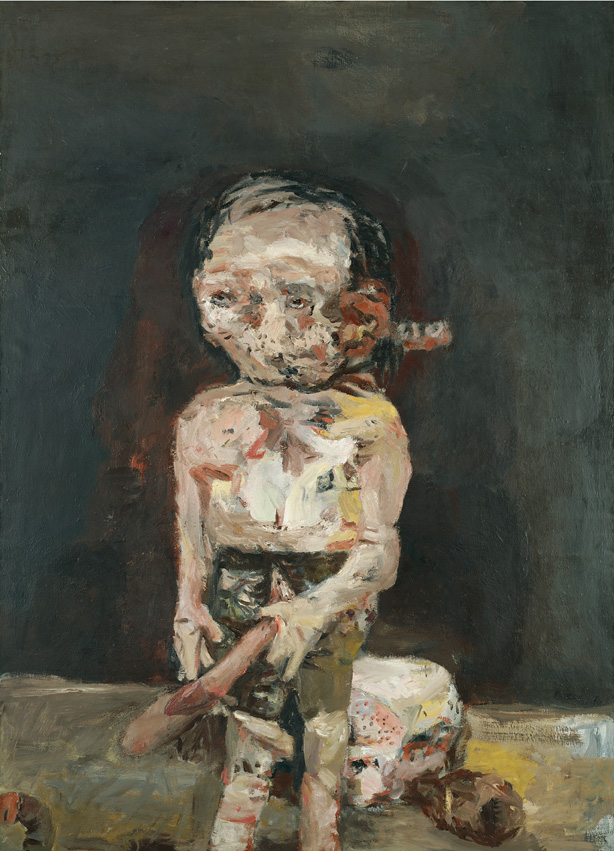
Georg Baselitz, Die große Nacht im Eimer (The Big Night Down The Drain), 1962 – 1963, oil on canvas, 98.4“ x 70.9.“ Ludwig Museum, Cologne. Photo: Jochen Littkemann, Berlin.
D.B. - It is honest to say that your work cannot be defined with metaphors of words in that the mystery of seeing is seeing the mystery. Even attempting an interview is largely impossible because we can only write in a metaphorical dimension. I can only skim the surface of insight into your creative processes. What are the patterns of your processes that rise to the surface after six decades of creating? Do you yourself understand each work fully?
G.B. - I do not let others paint for me, I’m not painted, nor does it paint with me. I have my thoughts very well together. My counterpart, my correspondent, was my past and that is still the case today. In addition, there are many images over the decades, which were very idiosyncratic and demanded a clear head.
D.B. - Could you unpack your sentence, “I do not let others paint for me, I’m not painted, nor does it paint with me.” Perhaps I am losing the essence of your statement in translation?
G.B. - There are many attempts to escape the essential. These unclear descriptions of what one does have led to very abstruse claims in recent decades. Like “I do not let others paint for me, I’m not painted, nor does it paint me”.
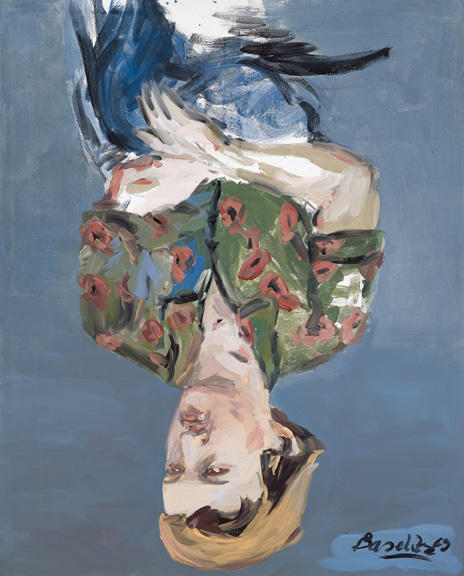
Georg Baselitz, Fünfzinger Jahre Porträt–M. W. (Fifties Portrait – M. W.), 1969, synthetic resin on canvas, 63.7” x 51.” Privately owned. © Georg Baselitz 2018. Photo: Jochen Littkemann.
D.B. - Many of your paintings beckon questions while others offer answers. Could it be that much of your work is born out of a realization of a benevolent awakening of the nature of the world as a reaction or epiphany to the path of cultural drama and trauma that you were born into?
G.B. - That, I believe, is not so, there is no therapeutic path for me, but there is my very hermetic world.
D.B. - Looking at your work, I sense something theurgical as part of your hermetic world. Does your painting have a goal of achieving some kind of unity, of reconciliation?
G.B. - I do not quite understand what you mean, reconciliation with whom? Or with what? I believe that expressing oneself by means of painting has a visible history which I am very interested in. I think it’s wonderful how Giotto painted and also how others have painted over the centuries. I can not find a philosophical, religious personal attitude of the painters in their art. I can certainly recognize that past periods of time are characterized by corresponding paintings. For me this does not mean any evaluation such as better paintings or worse paintings; also it does not signify progress as such.
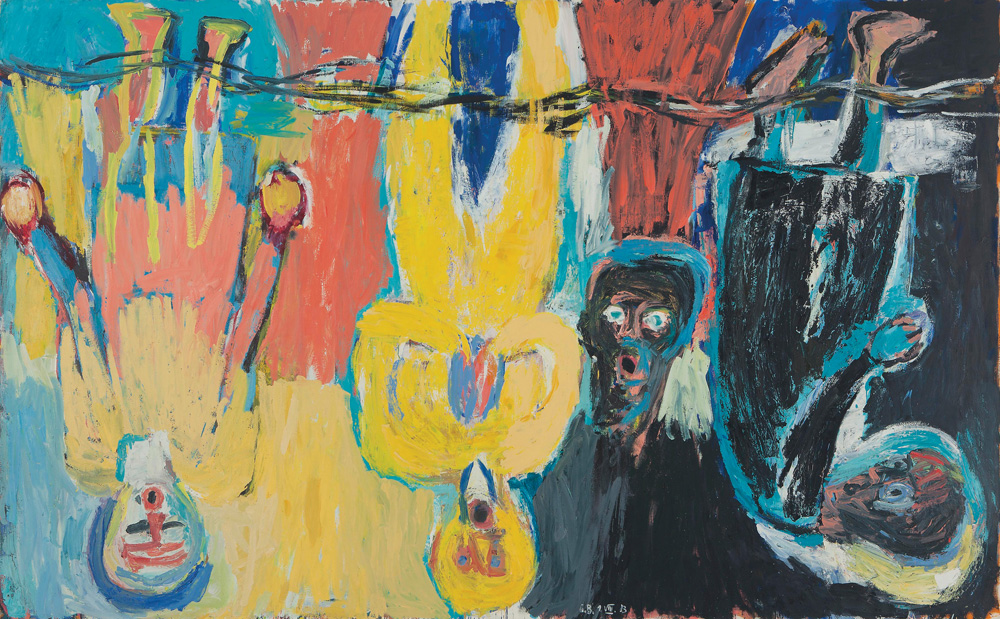
Georg Baselitz, The Brücke Chorus (Der Brückechor), 1983, oil on canvas, 110.2” x 177.” © Georg Baselitz 2018. Private collection. ©2014 Christie’s Images Limited.
D.B. - Does your up-side-down method become a bridge between the representational and the abstract as a condition of dialectics?
G.B. - I am not aware of this condition. You can talk about paintings a lot when you see them in front of you. But when you create these paintings, it does look very different. You make assertions and claim that they are valid, the final conclusion of wisdom. It must be incomparable-such a painting-and as incomprehensible as possible.
D.B. - Your inverted work titled ‘Edvards Geist’ offers us a narrative of death, friendship, love and the ambiguity of life as spirit against a field of black as death. The inverted element adds a stronger dimension to the title, opposite transitional directions, etc. Can you unpack this painting for me and what it means to you on a personal level?
G.B. - This spirit is the spirit, the spiritual apparition of Edvard Munch. I found out that Munch was the first important painter who had a great influence on me. As early as 1959 I made drawings according to his model. As of 1969 (inversion), there were many Munch quotations in my paintings, a dedication that could be viewed as a confession.

Georg Baselitz, Finger Painting – Eagle, 1972, oil on canvas, 98.4” x 70.9.” Bayerische Staatsgemäldesammlungen, Pinakothek der Moderne, Wittelsbacher Ausgleichsfonds, München. © Georg Baselitz, 2018. Photo: © Bayer&Mitko – ARTOTHEK.
D.B. - Along with Munch, within other works we see glimpses of Gorky and his use of vivid color depicting joy and innocence. Such a range of style presents itself as a form of honesty, a visual diary of a journey be it good or bad or melancholy. This is especially true in your “Hero” series. What is the foundation behind this raw honesty?
G.B. - I use a variety of designs of a specific visual appearance - and I do not conclusively refer to the outward appearance of visualization in this context - but also to the approach and method related in art history. In the end, the essence of such “content” or “motive” is based on quotations made by the artist which are characteristic for his/her art. I consider this my way of “congratulating”.
D.B. - You turned 80 this year. Your work has survived the modern era, the postmodern era and the meta-modern era. Do you see your work as a visual journey of becoming?
G.B. - A difficult question. First of all, I am a person who feels driven and at the same time, I am an active decision maker. All reactions lead to creativity and this, in turn, leads to paintings. My proclamations are paintings, my experiences too. Making discoveries while keeping logbooks about these paintings is important, in my case, ‘logpaintings.’ I think that new styles are always interesting news - just like inverted pictures.
D.B. - You have been quoted as stating that “The most intact world is the world of art.” Considering the deconstruction of painting for the past several decades, how is the art world intact?
G.B. - After all, art itself always rescues itself, remains preserved and visible to us. I often think of the pictures in the caves or catacombs. Destruction is construction at the same time even if it is merely mental instincts that come to life in pictures.
D.B. - There are no precedents for your wooden sculptures of busts. They appear to be prayers to the dead as victims of the war. Am I approaching their meaning?
G.B. - These sculptures work, even if they are motionless and not Calders, they violently contradict and at the same time fit in with the well-known ancestral sculptures. After all, Picasso, Giacometti, de Kooning, etc had all been there before them. There are figurative wooden steles in Africa, eg Bongo steles or from the Giryama from Kenya, which I like very much.
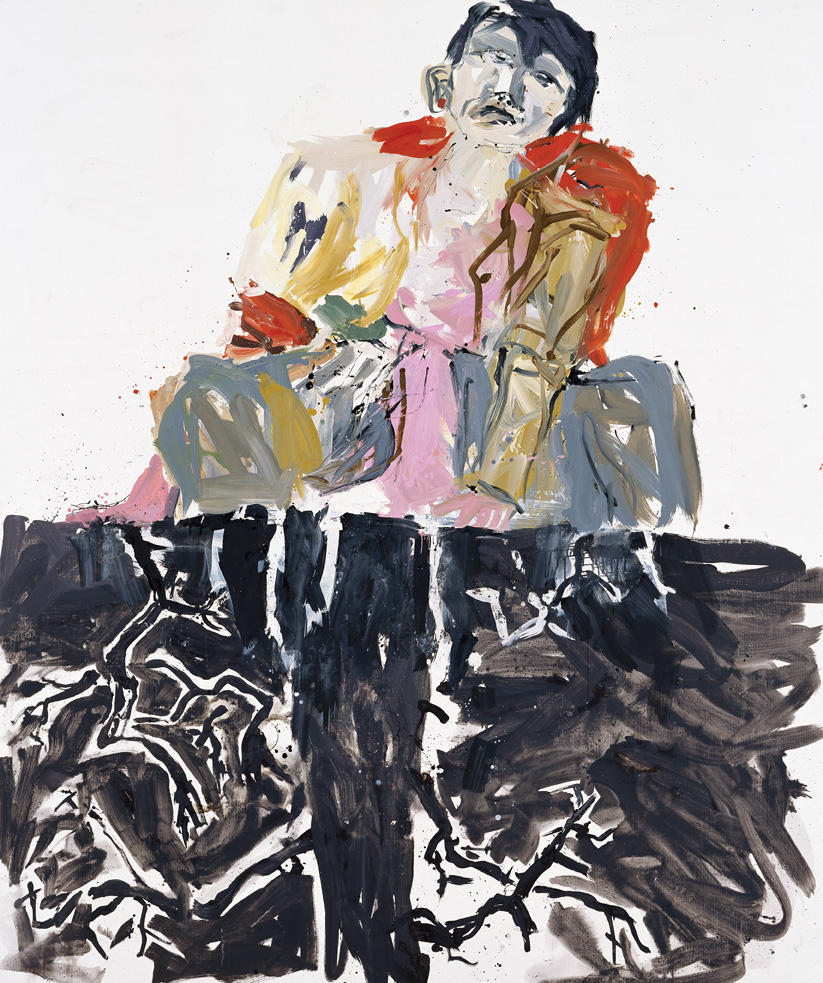
Georg Baselitz, Ein moderner Maler (Remix) / A Modern Painter (Remix), 2007, oil on canvas, 118“ x 98.4.“ Collection of Danny and Lisa Goldberg. Photo: Jochen Littkemann
D.B. - You state, “The idea of something being controllable is the most important factor to me. Not the subconscious or the visionary. Instead, I’m interested in the controllable.” In light of this statement and your latest works depicting aging, transitioning and death, are you letting go of that control?
G.B. - I do not think so. What would you, for example, say if I told you that I also work with myself as a counterpart with photos, these photos show me quite old. But it has actually become rather difficult to draw a straight line without trembling.
D.B.- Your “Remix” series offers up a reconstruct as opposed to a deconstruct of some of your most successful works. I can’t think of anyone who has ever done this before. Did you raise the works up to a higher level or did they simply become transformed into something else entirely?
G.B. - Yes, I think so, and I tried different things at different times in the past, and I was very happy to find this remix idea - it materialized from a dilemma I found myself in at the time. There is the aspect of freedom everyone talks about and everyone strives for because nobody really has it, and, according to my opinion, a repetition with a new biology of the artist creates freedom.
D.B. - A comment you made in an interview with Der Spiegel in January 2013-that women painters didn’t pass the market value test and couldn’t paint so well-was a comment that appears to have gone around the world for 5 years. After reading the question in its proper context I believe your answer was misunderstood as a prejudice against women artists. I felt you were saying that it is a male dominated art world which makes it harder for women to rise to the top of the market. Am I correct in my assumption? Do you wish to clarify the statement?
G.B. - I wrote a funny text about it. I put this below ***
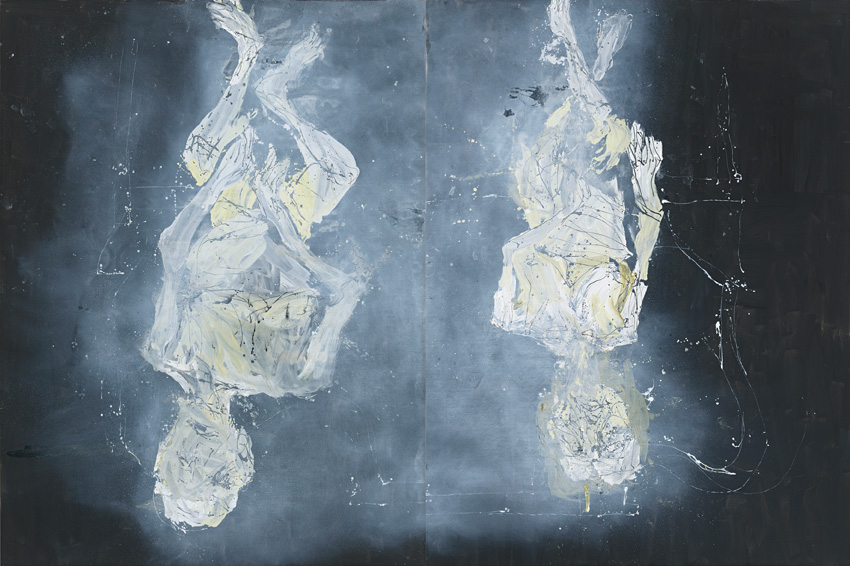
Georg Baselitz, Dystopian Couple, 2015, oil on canvas, 157.5” x 236.2.” Courtesy of the artist and White Cube. © Georg Baselitz, 2018. Photo: Jochen Littkemann.
D.B. - You were born into an era of post-WWII reconstruction. The oeuvre of embracing a deconstruct is in your DNA from a child. Your early “Hero” series is a lost young man who is searching for an identity in himself and his world as a result of this internal deconstruct. Am I correct in this assumption?
G.B. - Here they say “He can not get out of his skin/he can not help himself”, you say DNA. But you should not forget that we Germans since Nietzsche was born, consider ourselves as ‘over’ or ‘masters’, playing the ‘Aryan card’. This ideological nonsense had a beginning. I think it has not yet found an end. Images are generally subject to an aesthetic consideration between ugly and beautiful. In Germany the “Degenerate Art” was created for this reason.
D.B. - Your desire to produce a series of “bad” paintings, as a young painter, gave birth to a scandalous reputation as an artist from the beginning via the works Die große Nacht im Eimer (The Big Night Down the Drain) and Der nackte Mann (The Naked Man). You state now that you feel they were pathetic, pitiful and dirty. Then in 1969, you started inverting your work yet taking another major risk. The fact that these risks were made became defining moments for you. Is the dynamic of risk an intuitive part of your creative process or do you map out a painting?
G.B. - Even painters have nightmares that can put a lot of strain on them. And then you wake up and find yourself in a kind of normality. I believe that my geography is in this dichotomy, both one and the other and the attempt to wipe out the first-the nightmares.
D.B. - Could it be that you inverted your work as a form of protest against the U.S. capitalistic cultural influence, their rebuilding of Berlin post-WWII, and also as a response to the New York abstract expressionists that were dominating the art world in the 1960’s?
G.B. - The exhibition at my art school in Berlin in 1958 with American Abstract Expressionism resulted in my Große Nacht im Eimer. My foolish reaction in 1969 was the consequence of the iconoclasm of those years, - paper and canvas became unfit as medium.
D.B. - Therefore, to be clear, in spite of your iconoclasm acting out, inverting your paintings was actually a statement of protest?
G.B. - No, it’s not a protest, it’s just an independent, enhanced way to create images of what we call reality. After all, it’s possible to turn almost everything upside down - which makes sense. I found the American art that I saw in 1958 magnificent, but you must understand that the path that led to these paintings was completely unknown to me. I simply did not have the information.
D.B. - Your latest series on the finality of life appears to be about transitioning. They appear to be exclamation points into the mystery of death. Can you tell us what is behind the curtain?
G.B. - I think there are paintings behind the curtain. Really only paintings…. and in these paintings are people…. you can see them.
D.B. - What expectations did you hold upon turning 80 and can you reflect on an artist who has led you?
G.B. - You expect a high-altitude flight or maybe divine coincidence, I, however, have found a leader in Katsushika Hokusai.
D.B. - Hokusai was certainly not afraid of growing old. He died at age 88, exclaiming on his deathbed, “If only Heaven will give me just another ten years… Just another five more years, then I could become a real painter.” His art continually took on a sacred dimension, as in the writings of the Desert Fathers or mystics within a mindfulness form of visual Zen. What do you hold sacred? What do you hold as your defining moments?
G.B. - We have very different biographies in art history. Old and young, sick and healthy; also many artists we cannot identify - if you think of the caves or the catacombs. I can really not imagine that an artist thinks like maybe a scientist who has set himself the goal of blowing up the world with a bomb. I think of the artist as a very tiny creature within the frame of the overpowering daily life - an artist never has the chance to do something really dominant. Actually, I see all art as a very positive and friendly matter in our world, and that’s all it is and all that concerns me.

Georg Baselitz, Schlafzimmer (Bedroom), 1975, oil and charcoal on canvas, 98.4” x 78.74.” Privately owned. © Georg Baselitz 2018. Photo: Jochen Littkemann.
*** Man Makes Art for Woman’s Heart
Earlier today I saw the Venus of Willendorf - we don’t know who made her, if it was a man or a woman. I saw Botticelli’s Venus rising from a shell, I see Giorgione’s Venus (without the monkey), Titian’s Venus with her hair tied back, Velasquez’ Venus (from behind), Goya’s Venus - knees together and hands clasped behind her head (the Duchess of Alba) - I see Manet’s Venus (Le Déjeuner sur l’herbe), Rembrandt’s Venus (Bathsheba), and then there are the sculptors each with his own Venus, the many portraits of Venus by Cranach (long hair and fine, blue veins), and H. Rousseau’s voluptuous Venus on a sofa in the jungle - all made by men. Maybe some might be assuaged by the fact that Venus has a masculine ending.
The sculptors’ first Venus is the Venus of Willendorf - we will never know whether it was a man or a woman who made her - then the alabaster goddesses, the Queen of Sheba, the wondrous, female idols on the Cyclades, the countless Aphrodites hewn from marble with hammer and chisel - a man’s job, that physical effort - the many Graces with Paris, and lastly Pygmalion with his Lady Venus.
How many Venus de Milos might there be? There are even some by Bertel Thorvaldsen. From Michelangelo to Rodin, glorious beauties in bronze and marble. It was some time around 1900 that they started to deform, I don’t believe it had anything to do with the battle of the sexes, not like William Rubin who thought that domestic disputes led to Picasso’s women with three eyes. I think we’ve just had our fill of stone beauties.
Georg Baselitz, July 23rd, 2017 [unpublished]
Daniel Bonnell is an artist, writer and educator, as well as the author of the book Shadow Lessons, which chronicles an artist’s unexpected journey into an inner-city, at-risk, high school culture. He has exhibited his art in a variety of venues, including St. Paul’s Cathedral in London, St. George’s Cathedral in Jerusalem, Washington National Cathedral in Washington, D.C., and the Cathedral of St. John the Divine in New York City. His eclectic studio instructors included painter Ed Ross, photographer Ansel Adams and designer Milton Glaser.



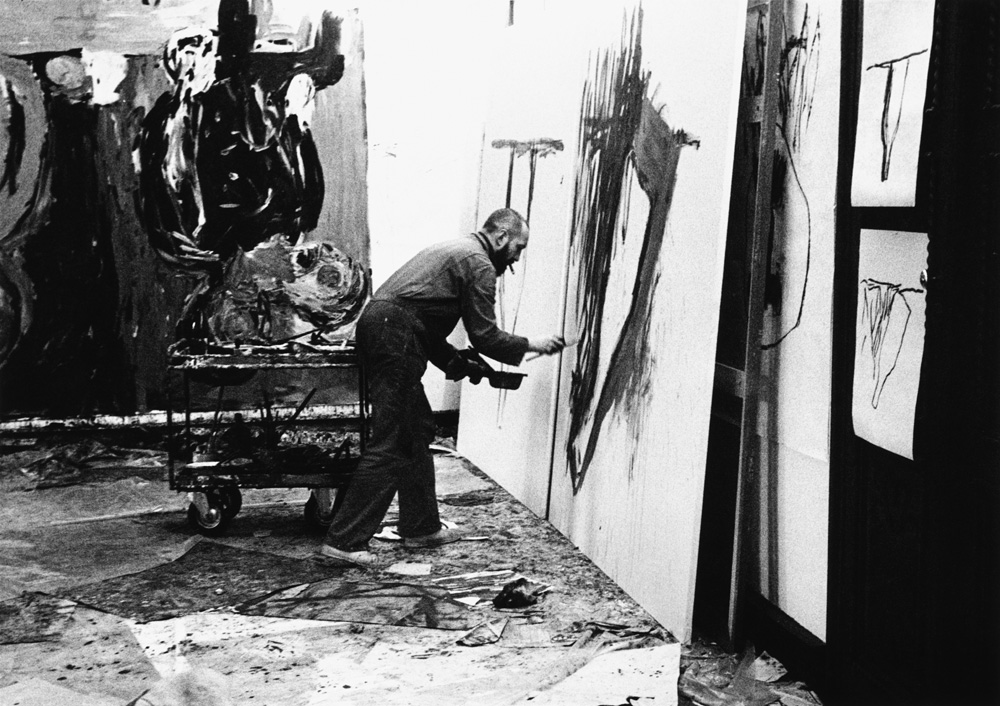


































Leave a Reply
You must be logged in to post a comment.